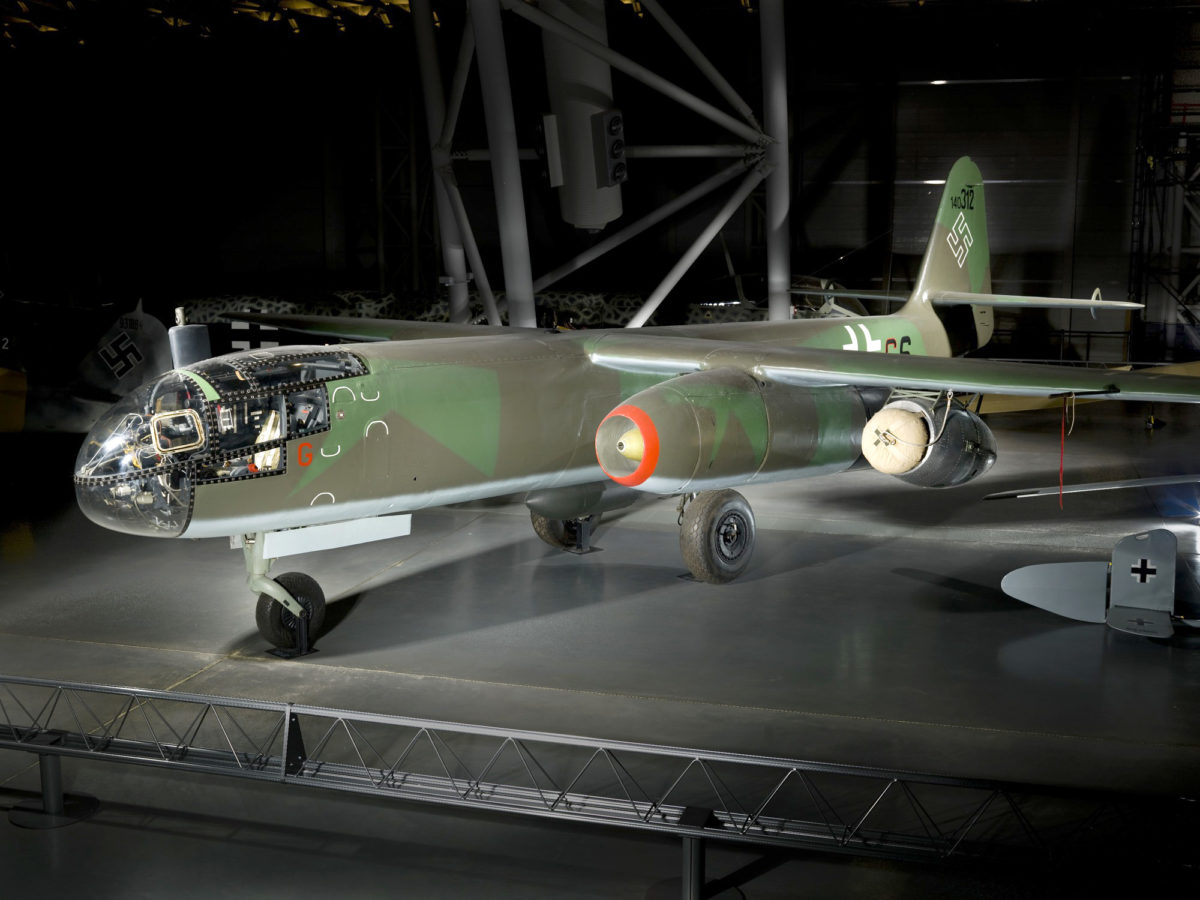No one at the Westphalia airfield outside Munster on July 30, 1943, knew just how important the flight they witnessed would be to the future of military aviation. That day marked the beginning of a cascade of events that would lead to the development of multiengine, long-range jet-powered bomber and reconnaissance aircraft.
When Walter Blume’s creation, dubbed the Arado 234, took to the air that summer day, aviation changed forever. The Ar-234 was a remarkable technological achievement for its day, but its innovation is chilling even today. Aircraft like the Ar-234, if introduced earlier or in larger numbers, could have turned the tide of World War II in favor of Nazi Germany.
Most discussions about turbojet aircraft development during WWII focus on the Messerschmitt Me-262, but that was only one of the many high-tech Luftwaffe jets. Just as the Me-262 was the ancestral jet fighter, the Ar-234 was the precursor of jet reconnaissance and bomber aircraft. The need for a long-range, high-speed scouting planes became evident as early as 1940, when Luftwaffe leaders realized that spying on the British Isles would not be as easy as they had originally thought because Britain was continuously beefing up its air defenses. So Theodor Rowehl, the chief of German special reconnaissance, enlisted the help of the Flugbaumeister (master aircraft builders/designers) and aerodynamicists of Arado to begin working on a solution to address the Third Reich’s reconnaissance shortcomings.
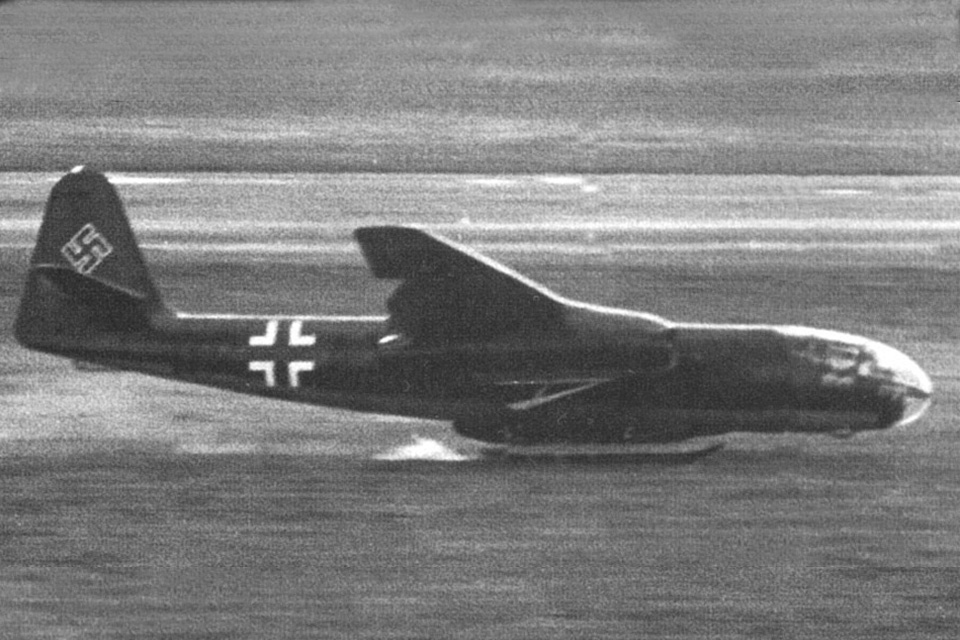
Expert glider pilot and manufacturer Egon Scheibe joined the Arado team to help tackle the design requirements proposed by the Luftwaffe, which called for speeds high enough to outrun propeller fighters and a range in the neighborhood of 1,250 miles. The resulting plan, designated E 370, was a combination of new technologies—a jet engine snug beneath each wing—and conventional glider concepts such as a tapered symmetrical wing, as well as low wing loading at landing weights. The Luftwaffe gave Arado’s innovative design the nod, and a development contract was awarded in early 1942.
Almost immediately following the initial approval of the E 370 project, German authorities requested more prototypes. At this point the project designation was altered to Ar-234. The additional example aircraft were to be all-metal. Equipped with larger cockpits, they also incorporated a bit more aerodynamic refinement. The original engine chosen for the Ar-234 was the axial-flow turbojet Junkers Motoren (Jumo) 004A, which during initial trials produced approximately 1,500 pounds of thrust. As it turned out, those engines did not immediately live up to performance expectations. Until that problem was rectified, a plan was put into place for rocket-assisted takeoffs using Walter 109-500 rockets that were jettisoned after use. Each of these hydrogen peroxide/ sodium permanganate rockets could boost thrust by 1,100 pounds for up to 30 seconds. Soon after this thrust augmentation development, the Luftwaffe requested an additional 14 prototypes.
In an amazing feat of engineering and manufacturing, the first Ar-234V1 rolled out of the hangar within 15 months of its birth on the drawing board. Even more astonishing is the fact that the Ar-234’s first test flight was essentially trouble-free. In fact, the test pilot stated that the aircraft required no major changes, and had only slight problems with control forces and engine synchronization. The primary early structural issue came with the landing gear. Due to the need to conserve weight (in order to increase range), conventional retractable landing gear was deemed too heavy. In its place, retractable landing skids were incorporated, with takeoffs assisted by a detachable trolley. Basically a sled with wheels, the trolley was supposed to be recovered after takeoff. However, the parachute used to arrest the trolley’s descent after being dropped malfunctioned with exasperating frequency. But even with that recurring problem, the Ar-234 was deemed a functional weapon. Although it was still a work in progress, the Luftwaffe pushed for the aircraft to go into production as soon as possible.
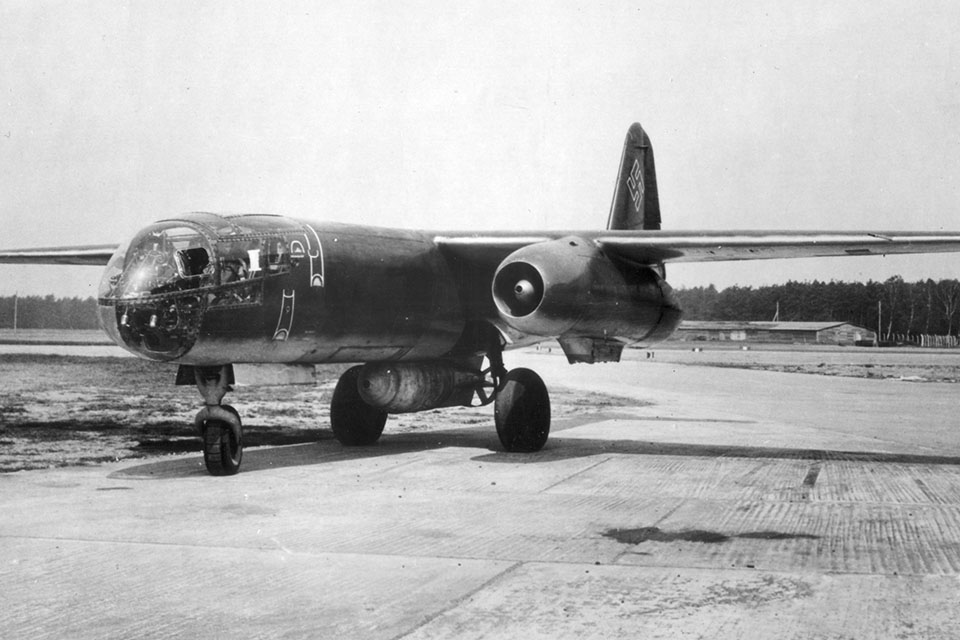
Not satisfied with the Jumo 004A, Arado opted for Jumo’s B model with an extra 450 pounds of thrust for prototype V5. In April 1944, following four months of trials, there was still some concern about the amount of available thrust. One proposed solution was to simply add more engines. Thus the Ar-234 became the first four jet engine–powered bomber/reconnaissance aircraft. This version utilized 1,760-pound-thrust BMW 003A-0 engines that were suspended in separate pods, two beneath each wing. Prototypes V6 (with four separate engine pods) and V8 (with two pods containing two engines each) would lay the foundations for the Ar-234C production models. Photoreconnaissance and formation flight tests of the various prototypes began in the summer of 1944.
With war efforts straining the Reich, it soon became apparent that higher speed bombers would be crucial to making a significant impact on Allied forces. The perceived success of the Ar-234 prototypes led to a Luftwaffe request to develop a bomber model. The first such type, the Ar-234B, was completed in the spring of 1944. Because of the troubles inherent with a trolley landing gear, the B model was fitted with retractable gear. The B model designation was further divided to demarcate specific uses. Aircraft with four reconnaissance cameras were B-1 models, while those with recon and bombing capability were designated B-2s. The B-2 could carry up to 3,300 pounds in various combinations, usually in the form of either one 2,200-pound bomb or one 3,300-pound bomb. The bomber could also be configured to carry two 1,100-pound bombs or several smaller, clusterlike bombs.
Another B-2 use was developed in October 1944. Due to its relative success and favorable flying qualities, the Ar-234 was seen as a great instrument/night flight platform. Thus the Nachtigall (nightingale) version was created. With an additional crew member serving as engineer and radar operator, the Ar-234 essentially became an all-weather, day or night assault aircraft.
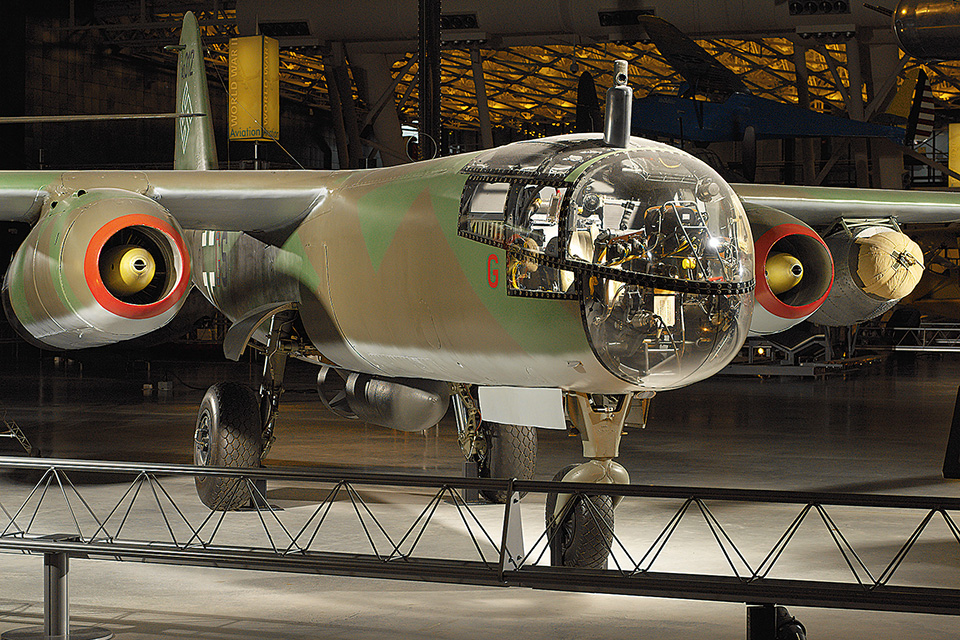
Each Ar-234 model and submodel had slightly different dimensions, weights and performance capabilities. Strangely, however, even German documentation disagrees on scores of dimensions and performance numbers. The best available data actually comes from the Ar-234B-2 in the possession of the Smithsonian’s National Air and Space Museum, which is presently on display at its Udvar-Hazy Center in Virginia. For that aircraft, the empty weight is just over 11,460 pounds, but reports show that A models weighed in at 9,400 pounds, while C models were a bit heavier at 13,400 pounds. Maximum takeoff weights (with rocket assistance) were 17,350 pounds for the A, 21,700 pounds for the B and 24,770 pounds for the C. Fuel tanks in the A and B models held about 6,600 pounds. C models could carry 7,700 pounds, including external fuel.
Ar-234As and Bs had a maximum speed of 460 mph above 19,000 feet. The C models were capable of 545 mph, with dive speeds reported as high as 610 mph. But speed was not the Ar-234’s only asset. Ar-234C-1 pilots also had the option to cruise at a lofty altitude of 41,000 feet, with other models cruising lower. The aircraft had a maximum range of 990 miles, depending on payload and weather conditions. With a full payload, a realistic range of 680 miles could be expected. All of that could be accomplished using airstrips with lengths less than 3,300 feet, thanks to rocket-assisted takeoffs and low landing speeds (90 mph).
The Ar-234’s performance capabilities are impressive even by today’s standards, considering the speed with which the design entered production and the limited expertise about jet engines at the time. But the Ar-234 also served as a test platform for many more remarkable technological advances. Its periscope system was used to sight rear-facing anti-aircraft guns fitted on some versions, as well as in conjunction with a bombsight system for barrage delivery. From V3 on, several of the Ar-234s were equipped with ejection seats. The later C models had a pressurized cabin, making high-altitude stints feasible. Some of the Arados were equipped with Patin PDS autopilots that would automatically adjust the aircraft heading to overfly a target that was observed in the Lofte 7K bombsight. The system could then drop the weaponry at the right moment. As impressive as this setup was, the process was a little awkward for the pilot. When approaching a target, the pilot had to engage the autopilot, slide the controls out of the way and then lean over the bombsight.
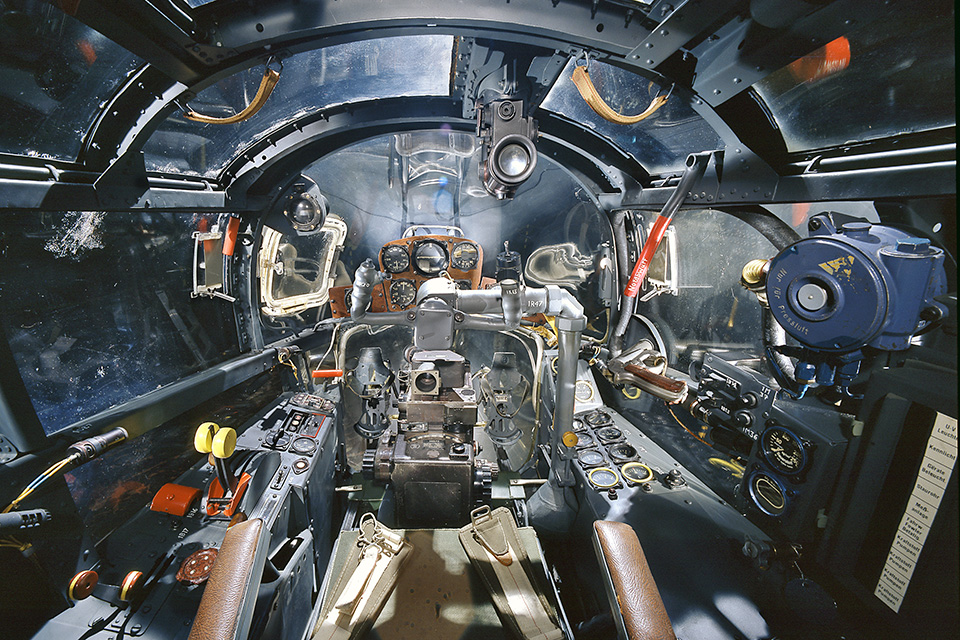
Aircraft produced after late 1944 were even more advanced, with a complex electrical system, onboard fire extinguishing systems, enhanced radio navigation, radar and improved communication equipment. Prob – ably the most striking innovation incorporated in the Ar-234 fleet was the concept of laminar flow wings and wing sweep. By February 1945, sweptwing designs were being tested. There were even plans for a swept and tapered winged Ar-234 that looked more like a modern aircraft than one from 1945. Another development in the works was a towed Deichselschlepp, or air trailer, which looked like a drone or glider. One planned used for this device was as an external fuel tank, complete with linking tubes to the mother ship. Another type of Deichselschlepp that was envisioned was a large buzz bomb type weapon (a pilotless flying bomb with its own propulsion system).
Unfortunately for the Germans, the unreliability of their turbojet engines, with average life spans of only about 10 hours of operation, limited the Ar-234’s impact on the war. Even when the engines worked properly, pilots struggled to manage them—a problem on the C version in particular, each of whose four engines seemingly had a mind of its own. When it became obvious that four engines would be too much for one pilot to handle, an additional crewman was added.
Although the Ar-234 did not reach its full potential, it did perform with some success. Several recon missions were completed from various bases throughout Germany and occupied territories. The Ar-234 was one of the few, if not the only, aircraft capable of supplying German commanders with photos of the Normandy beaches. On August 2, 1944, an Ar-234B-1 took off from Juvincourt, near Reims, France, to photograph the harbor being built by the Allies at Arromanches. Flying above 32,000 feet at more than 460 mph, the Arado went undetected. Within the next three weeks, two aircraft flew 13 recon missions without Allied interference. But pressure by the advancing Allied forces and an increasing number of air raids forced the Ar-234s into Holland and then, by the end of September 1944, back into Germany.
The bomber version (nicknamed “Blitz”) also achieved modest results. Ar-234B-2s from Kampfgeschwader 76 took part in the Ardennes offensive, delivering limited ordnance. The last major use of Ar-234 bombers came with an attempt to stop Allied forces from crossing a strategic bridge at Remagen. Flying with Me-262 fighter cover—which must have been an impressive sight—the Blitzes failed to make a direct hit on the structure. Although the bridge eventually succumbed to damage done by the Ar-234s, Allied forces had already built an alternative crossing.
The Nachtigall versions flew several missions, but entered service too late in the conflict to make much of a difference. The final airframes were delivered just before fighting ended in Europe.
During WWII, the Arado Alt Lonnewitz factory in Saxony built a total of 274 Ar-234s. Excluding prototypes, 220 Ar-234-Bs were produced as well as 14 Cs. While those numbers are impressive, many planes never made it into combat. Supply disruptions, material shortages, the scarcity of fuel and the constant pressures of the advancing Allies prevented the Ar-234s from realizing their full potential. By April 1945, only 38 remained: 12 bombers, 24 recon types and two Nachtigalls.
While the Ar-234 was only marginally successful during WWII, its advanced design and impressive components laid the foundation for modern military jets. As the first two- and four-engine jet-powered reconnaissance/bomber aircraft, there’s no doubt that the Ar-234 played a tremendous role in the development of post–WWII jets. If it had arrived earlier and had the benefit of more reliable turbojets, the Ar-234 could have posed a serious threat to the Allies. But regardless of whether it lived up to the Luftwaffe’s expectations, it was an amazing engineering feat for a time without computers.
David Ison is an assistant professor of aviation at Rocky Mountain College in Montana. Additional reading: The History of German Aviation: The First Jet Aircraft, by Wolfgang Wagner; and Arado Ar 234A, by Richard Smith.
Ready to build your a replica of an Arado AR-234 for your collection?
Originally published in the September 2008 issue of Aviation History. To subscribe, click here.

